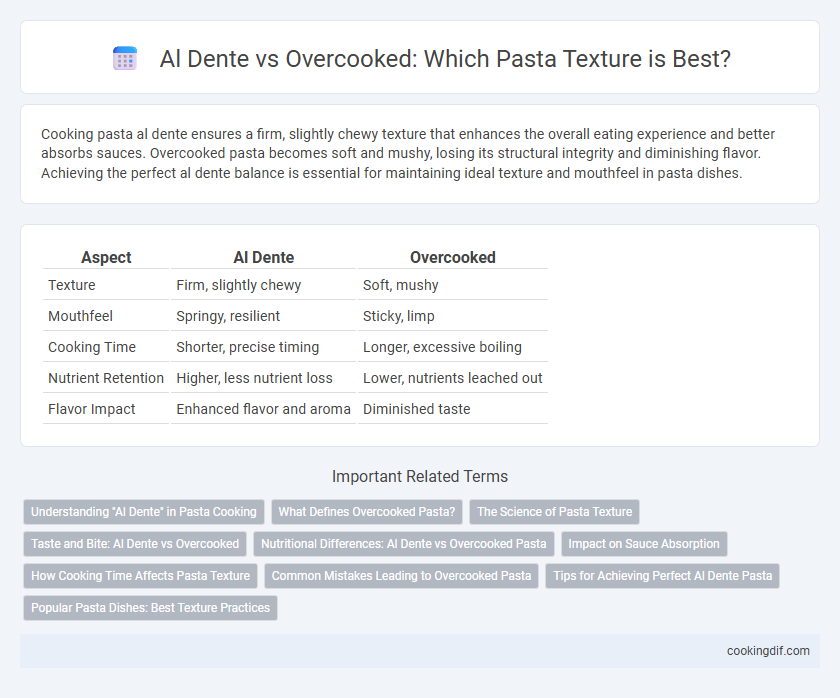Cooking pasta al dente ensures a firm, slightly chewy texture that enhances the overall eating experience and better absorbs sauces. Overcooked pasta becomes soft and mushy, losing its structural integrity and diminishing flavor. Achieving the perfect al dente balance is essential for maintaining ideal texture and mouthfeel in pasta dishes.
Table of Comparison
| Aspect | Al Dente | Overcooked |
|---|---|---|
| Texture | Firm, slightly chewy | Soft, mushy |
| Mouthfeel | Springy, resilient | Sticky, limp |
| Cooking Time | Shorter, precise timing | Longer, excessive boiling |
| Nutrient Retention | Higher, less nutrient loss | Lower, nutrients leached out |
| Flavor Impact | Enhanced flavor and aroma | Diminished taste |
Understanding "Al Dente" in Pasta Cooking
Al dente pasta, meaning "to the tooth," offers a firm yet tender texture that enhances both mouthfeel and sauce absorption, creating a balanced eating experience. Overcooked pasta becomes mushy and loses structural integrity, diminishing flavor and causing sauces to slide off rather than cling. Mastering the al dente cooking point ensures optimal texture, preserves nutritional value, and elevates traditional Italian dishes.
What Defines Overcooked Pasta?
Overcooked pasta is defined by its soft, mushy texture that lacks the firm bite characteristic of al dente pasta. When pasta is cooked beyond the optimal time, its starches break down excessively, resulting in a sticky and gummy consistency. This degradation affects both the mouthfeel and the ability to hold sauces effectively, diminishing the overall quality of the dish.
The Science of Pasta Texture
The science of pasta texture hinges on the balance between starch gelatinization and protein structure, where al dente pasta maintains a firm, chewy bite due to partially gelatinized starch and intact gluten networks. Overcooked pasta results from excessive water absorption and starch swelling, causing a mushy, fragile texture as the gluten structure breaks down. Achieving al dente texture optimizes mouthfeel and nutrient retention, enhancing both taste and digestive benefits.
Taste and Bite: Al Dente vs Overcooked
Al dente pasta offers a firm bite that enhances the overall texture and allows sauces to cling better, creating a balanced and flavorful experience. Overcooked pasta tends to be mushy, diluting the taste and resulting in a less satisfying mouthfeel. The perfect al dente texture preserves the wheat's natural flavor while providing a satisfying chew that complements a variety of sauces and ingredients.
Nutritional Differences: Al Dente vs Overcooked Pasta
Al dente pasta retains more resistant starch, which slows digestion and promotes better blood sugar control compared to overcooked pasta that releases more gelatinized starch leading to quicker glucose spikes. The firmer texture of al dente pasta also preserves more nutrients such as B vitamins and antioxidants that degrade with prolonged cooking. Choosing al dente pasta thus optimizes nutritional benefits by balancing digestibility and nutrient retention.
Impact on Sauce Absorption
Al dente pasta has a firm texture that allows it to hold sauces better by absorbing just the right amount of moisture, enhancing flavor integration. Overcooked pasta becomes mushy and waterlogged, causing sauces to slide off and lose their intended taste profile. Properly cooked pasta ensures an ideal balance between texture and sauce absorption, creating a harmonious dish.
How Cooking Time Affects Pasta Texture
Cooking time critically determines pasta texture, with al dente pasta offering a firm bite and slightly resistant center that enhances mouthfeel and prevents mushiness. Overcooked pasta becomes soft and gummy as starch granules absorb excess water and swell, leading to a loss of individual noodle integrity. Achieving precise cooking time ensures optimal texture, preserving the pasta's ideal elasticity and chewiness for enhanced culinary quality.
Common Mistakes Leading to Overcooked Pasta
Overcooked pasta results from boiling beyond the recommended time, causing a mushy texture that lacks the ideal firmness of al dente. Common mistakes include not setting a timer, underestimating cooking times for thinner or fresh pasta, and failing to test for doneness frequently during cooking. Properly al dente pasta should be tender yet firm to the bite, enhancing flavor absorption and mouthfeel.
Tips for Achieving Perfect Al Dente Pasta
Achieving perfect al dente pasta requires precise timing and careful attention to texture; cook pasta for 1-2 minutes less than package instructions and taste frequently to ensure a firm bite. Use plenty of salted boiling water to enhance flavor and prevent clumping, while stirring occasionally for even cooking. Immediately drain pasta and toss with sauce to stop cooking and preserve the ideal al dente texture that balances chewiness with tenderness.
Popular Pasta Dishes: Best Texture Practices
Achieving the perfect texture in popular pasta dishes hinges on mastering the al dente cooking method, which maintains a firm yet tender bite essential for dishes like spaghetti carbonara and penne arrabbiata. Overcooked pasta results in a mushy texture that dilutes sauce adherence and diminishes overall flavor intensity. Chefs recommend timing pasta to al dente to preserve structural integrity and enhance the dining experience in classic Italian recipes.
Al dente vs overcooked for texture Infographic

 cookingdif.com
cookingdif.com